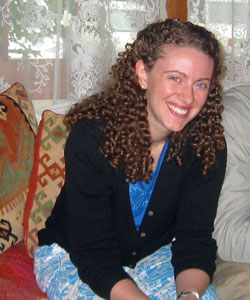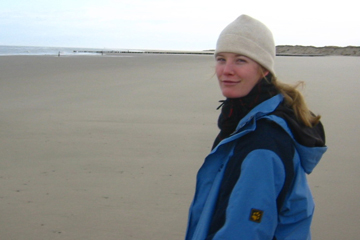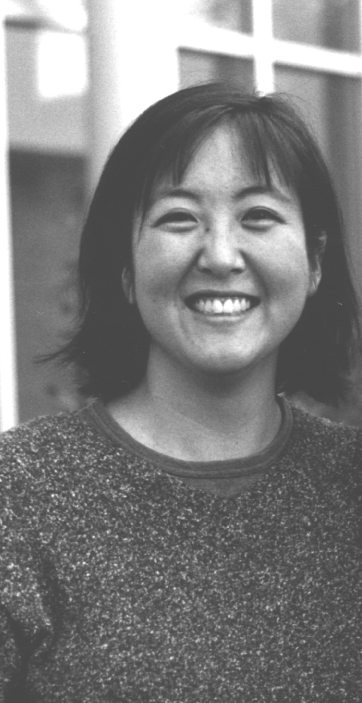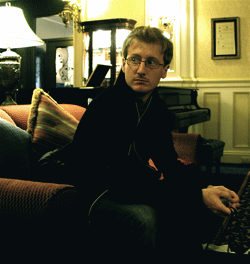| Graduate Students |
| Postdoctoral Fellows |
| Research Scientists |
| Undergraduate Students |
| Former Lab Members |
| Lab Pics |
|
Beth Thielen |
Brenna Kelley-Clarke |
Brook Vander Stoep Hunt |
Britta Molter |
Julia Dooher |
Michael Newman |
Lorne Walker |
Patti Kiser |
Mona Dellos |
Jessica Wisocky |
Chaowei Tsai |
Garrett Tomblingson
Beth Thielen 
Bio:
Beth Thielen grew up in New Brighton, MN and received her B.S. in Microbiology, summa cum laude from the University of Minnesota, Twin Cities. As an undergraduate she worked in the laboratories of Drs. Yoav Segal and Tucker LeBien at the University of Minnesota. While at the University of Minnesota, she also studied health care policy at Denmark's International Study Program in Copenhagen and worked for 2 years as a certified emergency medical technician (EMT) for the University of Minnesota Emergency Medical Response Team. Beth joined the Medical Scientist Training Program (MD/PhD program) at the University of Washington (UW) in 2003. After finishing her first two years of medical school and successfully completing the first part of the Medical Boards, Beth began her Ph.D. dissertation in the Lingappa lab in 2005. She received support from the CFAR STD/AIDS training grant pre-doctoral fellowship and Poncin scholarship starting in 2006, and received the ARCS (Achievement Rewards for College Scientists) award in 2007. She defended her Ph.D. in 2009 and is currently completing her medical school training at UW.
In her spare time, Beth enjoys cooking and ballroom dance.
Research in the Lingappa Lab:
- As a rotation student in the Lingappa lab, Beth established a cell-free system for assembly of Venezuelan equine encephalitis virus (VEEV) capsids. This is the first cell-free system for assembly of an alphavirus capsid. For her Ph.D. dissertation, Beth studied how the enzymatic activities of the cellular restriction factors APOBEC3G and APOBEC3A are regulated in primary human cells. APOBEC3 family members, which are cellular proteins that have antiviral activity against HIV-1 and other viruses, are cellular deaminases. Most studies of APOBEC3 proteins are performed on cells that have been transfected to express APOBEC3 proteins. In contrast, Beth’s studies focused on the enzymatic activity of APOBEC3 proteins expressed endogenously in primary human cells. To carry out these studies, she developed a quantitative, FRET-based high-throughput assay for detecting A3G deaminase activity. Using this assay, she demonstrated that A3G deaminase activity in human T cells is inhibited by an RNase-insensitive inhibitor (PLoS Pathogens 3(9):e135, 2007). Beth went on to demonstrate that while APOBEC3 deaminase activity remains low in primary human T cells despite treatment with a variety of cytokines, APOBEC3 enzymatic activity in primary human monocytes and macrophages undergoes a dramatic increase upon treatment with interferon alpha or interferon-alpha-inducing TLR ligands (Journal of Biological Chemistry 285(36): 27753-27766, 2010). In this paper, Beth used knockdown studies to demonstrate that the increase in deaminase activity in interferon alpha treated primary human monocytes is due entirely to induction of APOBEC3A, another member of the APOBEC3 family. She also showed that APOBEC3A enzymatic activity in primary human monocytes could be modulated by a variety of other signaling pathways. In contrast, APOBEC3A enzymatic activity could not be induced by interferon alpha in two different monocytic cell lines. Thus, in primary human T cells, monocytes, and macrophages, the enzymatic activity of APOBEC3 proteins is under the control of regulatory pathways that are not present in transformed cell lines typically used to study APOBEC3 proteins.
Publications:
- Innate immune signaling induces high levels of TC-specific deaminase activity in primary monocyte-derived cells through expression of APOBEC3A isoforms.
- Beth K.Thielen, John P. McNevin, M. Juliana McElrath, Brook Vander Stoep Hunt, Kevin C. Klein, and Jaisri R. Lingappa. Journal of Biological Chemistry 285(36): 27753-27766, 2010.[Download]
- Thielen BK, Klein KC, Walker LW, Rieck M, Buckner JH, Tomblingson GW, and Lingappa JR. T cells contain an RNase-insensitive inhibitor of APOBEC3G deaminase activity. PLoS Pathogens, 2007 Sep 21;3(9):1320-34. [Article]
- Rheault MN, Kren SM, Thielen BK, Mesa HA, Crosson JT, Thomas W, Sado Y, Kashtan CE, Segal Y. Mouse model of X-linked Alport syndrome. J Am Soc Nephrol. 2004 Jun;15(6):1466-74.[Abstract ]
- Thielen BK, Barker DF, Nelson RD, Zhou J, Kren SM, Segal Y. Deletion mapping in Alport syndrome and Alport syndrome-diffuse leiomyomatosis reveals potential mechanisms of visceral smooth muscle overgrowth. Hum Mutat. 2003 Nov;22(5):419.[Abstract ]
Brenna Kelley-Clarke 
Bio:
Brenna was a post-doctoral fellow in the Lingappa lab from 2006-2010. Prior to her postdoctoral work, Brenna earned her PhD from Harvard University; her dissertation work in the laboratory of Dr. Kenneth Kaye focused on the latency-associated nuclear antigen (LANA) of Kaposi's sarcoma-associated herpesvirus (KSHV). During her time as a postdoctoral fellow in the Lingappa lab, Brenna identified an early intermediate in the assembly pathway for Venezuelan equine encephalitis virus (VEEV) and studied novel drugs that inhibit this pathway (Kelley-Clarke et al., manuscript submitted). During her postdoctoral fellowship, Brenna was funded by an NIH F32 postdoctoral fellowship.
Brenna left the Lingappa lab in 2010 to take a Scientist position at Immune Design Corporation, a Seattle biotech, where she is working with a team to design a lentivector-based renal cancer vaccine. In her spare time, Brenna plays cello in the Puget Sound Symphony Orchestra.
Publications:
Role of Kaposi's sarcoma-associated herpesvirus C-terminal LANA chromosome binding in episome persistence.
Kelley-Clarke B, De Leon-Vazquez E, Slain K, Barbera AJ, Kaye KM.
J Virol. 2009 May;83(9):4326-37.
Determination of Kaposi's sarcoma-associated herpesvirus C-terminal latency-associated nuclear antigen residues mediating chromosome association and DNA binding.
Kelley-Clarke B, Ballestas ME, Srinivasan V, Barbera AJ, Komatsu T, Harris TA, Kazanjian M, Kaye KM.
J Virol. 2007 Apr;81(8):4348-56.
Kaposi's sarcoma herpesvirus C-terminal LANA concentrates at pericentromeric and peri-telomeric regions of a subset of mitotic chromosomes.
Kelley-Clarke B, Ballestas ME, Komatsu T, Kaye KM.
Virology. 2007 Jan 20;357(2):149-57.
Kaposi's sarcoma-associated herpesvirus LANA hitches a ride on the chromosome.
Barbera AJ, Chodaparambil JV, Kelley-Clarke B, Luger K, Kaye KM.
Cell Cycle. 2006 May;5(10):1048-52.
The nucleosomal surface as a docking station for Kaposi's sarcoma herpesvirus LANA.
Barbera AJ, Chodaparambil JV, Kelley-Clarke B, Joukov V, Walter JC, Luger K, Kaye KM.
Science. 2006 Feb 10;311(5762):856-61.
Evaluation of the conformational switch model for alfalfa mosaic virus RNA replication.
Petrillo JE, Rocheleau G, Kelley-Clarke B, Gehrke L.
J Virol. 2005 May;79(9):5743-51.
On the role of the starved codon and the takeoff site in ribosome bypassing in Escherichia coli.
Gallant J, Bonthuis P, Lindsley D, Cabellon J, Gill G, Heaton K, Kelley-Clarke B, MacDonald L, Mercer S, Vu H, Worsley A.
J Mol Biol. 2004 Sep 17;342(3):713-24.
KSHV LANA1 binds DNA as an oligomer and residues N-terminal to the oligomerization domain are essential for DNA binding, replication, and episome persistence.
Komatsu T, Ballestas ME, Barbera AJ, Kelley-Clarke B, Kaye KM.
Virology. 2004 Feb 20;319(2):225-36.
Brook Vander Stoep Hunt 
Bio:
Brook Vander Stoep Hunt was raised in Seattle, WA. She majored in Microbiology at the University of California at Santa Barbara (UCSB), and graduated with Highest Honors in 2007. As an undergraduate, she was frequently on the Dean's list and received numerous other honors for her academic scholarship, including an award for "Outstanding Critical Thinking and Analysis in the Laboratory" from the UCSB Dept. of Chemistry. While at UCSB, she worked in the laboratory of Dr. Kevin Plaxco in the Dept. of Chemistry. Brook was a research scientist in the Lingappa laboratory from 2007 – 2009. In 2009, she left the Lingappa lab to join the Cancer Biology Ph.D. program at Stanford University. Her Ph.D. dissertation studies are in the laboratory of Dr. Paul Khavari, in the Dept. of Dermatology at Stanford University.
Research in the Lingappa Lab:
Brook worked closely with Beth Thielen in the Lingappa lab, studying regulation of the deaminase activity of various APOBEC3 proteins expressed in primary human cells.
Publications:
- Innate immune signaling induces high levels of TC-specific deaminase activity in primary monocyte-derived cells through expression of APOBEC3A isoforms. Beth K.Thielen, John P. McNevin, M. Juliana McElrath, Brook Vander Stoep Hunt, Kevin C. Klein, and Jaisri R. Lingappa. Journal of Biological Chemistry 285(36): 27753-27766, 2010. [Abstract]
- Effects of probe length, probe geometry, and redox-tag placement on the performance of the electrochemical E-DNA sensor. Lubin AA, Hunt BV, White RJ, Plaxco KW. Anal Chem. 2009 Mar 15;81(6):2150-8. [Abstract]
Britta Molter 
Bio:
Britta grew up in Warendorf, a small town in northwestern Germany. She studied biology at the Westfalian Wilhelm‘s University of Münster. In 2003, she received the ERASMUS Mundus Scholarship to study abroad in Trondheim, Norway. She was granted the DAAD (Deutscher Akademischer Austauschdienst) Scholarship to conduct her master’s thesis research at the University of Washington in 2005. For her master’s thesis, she investigated the behavior of Malayan sun bears in captivity and correlated it to social conditions and endocrine measurements. In 2006, she obtained her Master’s degree in Biology, with emphases on behavioral biology and biochemistry. Britta was a research scientist in the Lingappa lab from 2006 – 2008. In 2008, Britta returned to Germany, where she now spends her time raising her two children
Research:
Britta joined the Lingappa lab in 2006 and is part of the HIV assembly team. She is working closely with Jonathan Reed to identify novel cellular factors critical for HIV assembly and to understand their mechanisms of action.
Julia Dooher 
Julia Dooher grew up in Melrose, MA and received her BS in Biology, Magna
cum Laude, from Tufts University. As an undergraduate, she worked in the laboratory
of Tom Gilmore at
Boston University, and was a recipient of an NSF undergraduate summer research
award and Lemelson Fellowship from Hampshire College. As a graduate student
in the Lingappa Lab, Julia received an NSF graduate fellowship, an ARCS Foundation
award, a UW Magnuson Scholarship, and the 2005 UW Pathobiology Dept. Outstanding
Student Award. Julia was awarded her PhD from the University of Washington
Dept. of Pathobiology in November 2005.
Julia has a long-standing interest in photography, and her photographs of
landscapes taken on a cross country trip and a trip to Europe have been featured
in Bricolage, the UW Literary and Arts Journal.
Research:
Julia spearheaded a number of new directions in the Lingappa Lab. She demonstrated
that Gag polypeptides of diverse primate lentiviruses associate with ABCE1 in
primate cells, even though these Gag proteins have limited sequence homology.
Julia also used apyrase, an enzyme that hydrolyzes ATP, to trap elusive capsid
assembly intermediates, allowing such intermediates to be identified biochemically
in cells for the first time (Dooher and Lingappa 2004).
More recently, Julia used a pulse-chase labeling approach to demonstrate that
in primate cells HIV-1 Gag enters ABCE1-containing complexes within minutes
after synthesis and exits these complexes just before virus maturation and
release begins. Julia’s pulse-chase studies of HIV-1 mutants suggest that when
progression of Gag through ABCE1-containing assembly intermediates is slowed,
virus release is also delayed, suggesting that viral-host interactions can
alter virion production. Along with Bobbie Schneider at the FHCRC
Electron Microscopy lab, Julia piloted an immunogold labeling electron
microscopy techniques to confirm that HIV-1 Gag colocalizes with ABCE1 at sites
of assembly at the plasma membrane (Dooher, Schneider, Reed and Lingappa 2007).
Julia also initiated a project to study how highly pathogenic viral variants may have evolved to utilize ABCE1 more efficiently than less pathogenic isolates from which they are derived.
Publications:
- Wang Y, Dooher JE, Koedood Zhao M, Gilmore TD. Characterization of mouse
Trip6: a putative intracellular signaling protein. Gene. 1999 Jul 8;234(2): 403-9.
- Barkett M, Dooher JE, Lemonnier L, Simmons L, Scarpati JN, Wang Y,
Gilmore TD. Three mutations in v-Rel render it resistant to cleavage
by cell-death protease caspase-3. Biochem Biophys Acta. 2001 Apr 3;
1526(1):25-36.
- Dooher, J. E. and J. R. Lingappa. Cell-free capsid assembly of primate
lentiviruses from three different lineages. Journal of Medical Primatology,
33: 272-280, 2004.
[Abstract]
- Dooher, J. E., M. Pineda, J. Overbaugh, and J. R. Lingappa.
Characterization of virus infectivity and cell-free capsid assembly of
SIVmneCL8 and SIVmac239. Journal of Medical Primatology, 33: 262-271, 2004.
[Abstract]
- Dooher, J. E. and J. R. Lingappa. Cell-free capsid assembly of primate
lentiviruses from three different lineages. Journal of Medical Primatology,
33: 272-280, 2004.
[Abstract]
- Dooher JE, Lingappa JR. Conservation of a step-wise, energy-sensitive
pathway involving HP68 for assembly of primate lentiviral capsids in cells. Journal of Virology,
78: 1645-1656, 2004. [Abstract]
- Lingappa, J. R., M. A. Newman, K. C. Klein, and J. E. Dooher. Comparing
capsid assembly of primate lentiviruses and hepatitis B virus using
cell-free systems. Virology 333: 114-123, 2005.
[Abstract ]
- Lingappa JR, Dooher JE, Newman MA, Kiser PK, Klein KC. Basic residues in the nucleocapsid domain of gag are required for interaction of HIV-1 gag with ABCE1 (HP68), a cellular protein important for HIV-1 capsid assembly. J Biol Chem. 2005 Feb 17;281(7):3773-84. [Abstract]
- Dooher, Julia E., Schneider, Bobbie L., Reed, Jonathan C. & Lingappa, Jaisri R. (2006)
Host ABCE1 is at plasma membrane HIV assembly sites and its dissociation from Gag is linked to subsequent events of virus production.
Traffic. 2007 Mar; 8(3):195-211[Abstract]
Michael Newman 
Bio:
Michael Newman was a member of the Lingappa lab from 2003 – 2006, and obtained his M.S. degree from the Dept. of Pathobiology in June 2006.
Publications:
- Lingappa JR, Dooher JE, Newman MA, Kiser PK, Klein KC. Basic residues in the nucleocapsid domain of Gag are required for interaction of HIV-1 Gag with ABCE1 (HP68), a cellular protein important for HIV-1 capsid assembly. J Biol Chem. 2006 Feb 17;281(7):3773-84. [Abstract]
- Lingappa, J. R., M. A. Newman, K. C. Klein, and J. E. Dooher. Comparing
capsid assembly of primate lentiviruses and hepatitis B virus using
cell-free systems. Virology 333: 114-123, 2005.
[Abstract ]
Patti Kiser 
Bio:
Patti Kiser was a member of the Lingappa lab from 2000 to 2003, and obtained her M.S. degree from the Dept. of Pathobiology in June 2003.
Patti's Publications with the Lingappa Lab:
- Lingappa JR, Dooher JE, Newman MA, Kiser PK, Klein KC. Basic residues in the nucleocapsid domain of gag are required for interaction of HIV-1 gag with ABCE1 (HP68), a cellular protein important for HIV-1 capsid assembly. J Biol Chem. 2005 Feb 17;281(7):3773-84. [Abstract]
- Zimmerman C, Klein KC, Kiser PK, Singh AR,
Firestein BL, Riba SC, Lingappa JR. Identification of a host protein essential for
assembly of immature HIV-1 capsids. Nature. 415(6867): 88-92, Jan 2002
[Abstract]
[PDF]
Lorne Walker 
Bio:
Lorne Walker graduated from UW in June 2002 with a double major in Biochemistry and Applied and Computational Mathematical Sciences. He was a technician in the Lingappa lab from 2002 – 2005 and was involved in a wide variety of projects. He is currently an MD PhD student in the UC San Diego MSTP program.
Publications:
- Thielen BK, Klein KC, Walker LW, Rieck M, Buckner JH, Tomblingson GW, and Lingappa JR. T cells contain an RNase-insensitive inhibitor of APOBEC3G deaminase activity. PLoS Pathogens, accepted June 2007.
Mona Dellos 
Bio:
Mona Dellos worked in the Lingappa lab while she was an undergraduate at UW. She worked closely with Kevin Klein, a graduate student in the lab, on the assembly of Hepatitis C virus. Mona is now a member of the Lagunoff Lab in the Dept. of Microbiology at UW.
Publications:
- Klein, K. C., S. R. Dellos, and J. R. Lingappa. Identification of residues in the core protein that are critical for assembly of hepatitis C virus capsids using a cell-free system. Journal of Virology. 2005 Jun;79(11):6814-26. Erratum in: J Virol. 2005 Aug;79(15):10098.
[
Abstract]
Jessica Wisocky 
Bio:
Jessica Wisocky worked as a lab helper in the Lingappa Lab in 2005.
Chaowei Tsai 
Bio:
Chaowei grew up in Taiwan and moved to Washington with his family in the summer of 1997. He is currently an undergraduate at the University of Washington, majoring in Microbiology and Biochemistry. He was a technician with the Lingappa Lab in 2005.
Garrett Tomblingson  photo by MV Santos
photo by MV Santos
Bio:
Garrett was a research technician in the Lingappa Lab between August 2005 and June 2007.
Publications:
- Thielen BK, Klein KC, Walker LW, Rieck M, Buckner JH, Tomblingson GW, and Lingappa JR. T cells contain an RNase-insensitive inhibitor of APOBEC3G deaminase activity. PLoS Pathogens, accepted June 2007.

|













